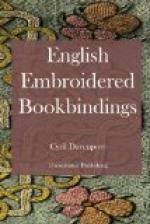[Illustration: 20—Christian Prayers. London, 1570.]
The back is divided into five panels bearing alternately Yorkist roses of pearls and Tudor roses of red silk and pearls, all worked in the same way as the roses on the sides.
The illustration I give of this binding (Frontispiece) is necessarily a restoration. But there is nothing added which was not originally on the book. Each pearl that has disappeared has left a little impress on the velvet, and so has each piece of gold cord which has been pulled off. The back is still existing; but bad though both sides and back now are, it is much better they should be in their present condition than that they should have been mended or replaced in parts by newer material.
Christian Prayers. London, 1570.
A simpler binding, but still one of great richness, covers a copy of Christian Prayers, printed in London in 1570.
This is covered in crimson velvet, measuring 6 by 3-1/2 inches, and is worked largely with metal threads, mixed with coloured silks. In the centre is the crest of the family of Vaughan—a man’s head with a snake round the neck. The crest rests on a fillet, and is enclosed in a twisted circle of gold with four coloured bosses. From the upper and lower extremities of this circle spring two flower forms in gold and silver guimp, with sprays issuing from them bearing strawberries, grape bunches, and leaves, in the upper half, and roses and leaves in the lower. The grapes are represented by rather large spangles, and the leaves, worked in gold, have a few strands of green silk in them; large spangles, kept down by a short piece of guimp, are used to fill in spaces here and there. This is the first instance of the use of spangles on a velvet book. The back is tastefully ornamented with gold cord arranged diamond-wise, and having in each diamond a flower worked in gold.
Parker, De antiquitate Ecclesiae Britannicae. London, 1572.
This is one of the embroidered books that belonged to Queen Elizabeth, and has been frequently illustrated and described. It is remarkable in other respects than for its binding, as it is one of a number of probably not more than twenty copies of a work by Matthew Parker, Archbishop of Canterbury, De antiquitate Ecclesiae Britannicae, printed for him by John Day in London, 1572. It was the first instance of a privately printed book being issued in England.
[Illustration: 21—Parker, De antiquitate Ecclesiae Britannicae. London, 1572.]
Archbishop Parker had a private press, and his books were printed with types cast at his own cost, John Day being sometimes employed as his workman. No two copies of this particular work are alike, and it is supposed that the Archbishop continually altered the sheets as they came from the press and had the changes effected at once. The book has two title-pages, each of which, as well as a leaf containing the arms of the Bishops in vellum, the ornamental borders, and coats-of-arms throughout the book, are emblazoned in gold and colours.




